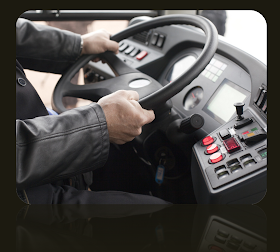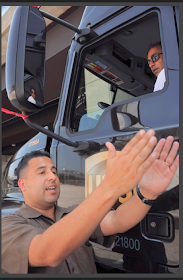" Marathon Coach is the world’s largest
manufacturer of luxury bus conversions "
Marathon Coach is the world’s largest
manufacturer of luxury bus conversions. Its business is building leisure
type buses for the ultimate in creature comfort. Prevost, a company based in
Quebec, Canada, provides Marathon with a passenger bus chassis that Marathon
employees convert into a luxury coach. Marathon offers two styles of
coaches: the H3-45 that is 45’ long and 12’-1” tall, and the XLII that is
40’ or 45’ long and 11’-7” tall. The interior of each coach is customized so
that no two Marathon coaches are alike. The Prevost chassis carries a
500-horseower Detroit Diesel Series 60 engine, Allison World six-speed
automatic transmissions, and 20-kilowatt Kohler auto-gen generators. Beside
custom coaches, Marathon also builds corporate coaches, customized specialty
trailers and transporters. Marathon has sales and service offices in San
Antonio, Florida and Dallas, Texas. It has been in business since 1983.
 Sample floor plan
Sample floor plan
|
Marathon has six to eight basic floor plans for
its coaches. The interior floor plan provided in this article shows the
layout of a typical Marathon coach. From available floor plans, a customer
selects anything from flooring to window treatments. Because of the number
options that Marathon provides, a customer usually has to visit the Marathon
plant two or three times to ensure that his or her specifications are met.
Some customers may first lease a Marathon coach to see what it’s like. If
the customer likes it, he or she will have Marathon build a customized one.
The resale value is good for a previously owned coach, so in many ways,
buying a luxury motorhome is like buying a house. Marathon also has spec
coaches that are built for trade shows; however, these coaches aren’t sold.
When a Prevost passenger bus shell arrives at
Marathon’s manufacturing facility, it comes with virtually nothing inside
except foam walls and flooring (often referred to as bowling alleys by
industry insiders). Also, some of the windows are different from those on a
normal passenger bus. Marathon employees then begin to customize each coach
to the customer’s specifications. An electric generator, plumbing, and other
equipment are installed, which accounts for about 50% of the actual work.
The rest is decorating and furnishings. All of the engineering and
customized designs are on Marathon’s computer systems in Coburg, along with
inventory records for necessary parts and supplies.
Besides the equipment mentioned above, other
standard features of a typical Marathon coach include:
• stereo systems in the front, rear, and outdoor entertainment compartments;
• global-positioning mapping systems with pilot and co-pilot screens;
• TechLink® (Marathon's intelligent electrical network);
• full-size refrigerators;
• built-in washer/dryer units;
• standard convection/microwave ovens; and
• European-style cabinetry.
Another standard feature of a Marathon coach is a satellite dish. There are
two types: a stationary dish that has to be manually pointed at a satellite;
and a follow-me (or in-motion) satellite that rotates automatically to find
the signal. Long-term leased coaches are set up with a follow-me satellite
that has a GPS (Global Positioning System) that locks onto the signal. A
white dome on top of the roof covers this type of satellite. Tora Takagi’s
coach has four receivers for four TVs. Satellite dishes also have track
feeds to each receiver because CART drivers and teams need to view timing
and scoring during a race weekend.
One amenity Marathon coaches offer is a slide-out. (Slide-outs are side
compartments that can be extended when a coach is parked to provide more
living space.) Salon and bedroom slide-outs are available for both styles of
Marathon coaches. Jeff Gordon has a triple slide-out for the front left of
his Marathon coach, plus slide-outs for both sides of the bedroom. His
slide-outs cost about $300,000. A single slide-out is typically 10’ x 3’, so
about 30 sq. ft is added with each one. A mechanism in the flooring makes
the slide-outs level with the rest of the flooring. The interior is then
designed around the slide-outs.
More exotic items that have been included in some custom coaches are hot
tubs, saunas, built-in treadmills and corporate conference rooms.
Marathon’s biggest market is Saudi Arabia where a sheik is Marathon’s
largest single buyer. Most of the rest of Marathon’s business is with
private owners, such as Tim Allen and other Hollywood stars. Auto racing
represents the next largest business segment. Marathon got started in auto
racing in 1995 by providing coaches for drivers. Besides CART, Marathon also
provides coaches for NASCAR, NHRA (for example, John Force) and the IRL.
Marathon Coaches in CART
 Inside Alex Zanardi's
2001 Motorhome
Inside Alex Zanardi's
2001 Motorhome
|
This year in CART, Marathon has five motorhomes
for Takagi (subleased from Charlie Sheen), Michael Andretti, Newman-Haas,
Team Players, and Tony Kanaan. Also, Mo Nunn’s team has a 53-ft. Marathon
trailer for media and hospitality. In the IRL, Marathon provides two
Marlboro coaches, one Team Penske coach, two Kelley Racing coaches, and some
others that have short-term leases (one year or less). CART drivers and
teams select when and where they would like to lease a Marathon coach based
on convenience. For example, if a CART driver or team doesn’t want to drive
to a hotel during a race weekend, they may choose to lease a coach for a
short period.
The Newman-Haas coach is a VIP model used
strictly as an office; it has no beds or shower. (Carl Haas prefers to stay
at a hotel.) The WorldCom coach is a VIP one for the media.
CART drivers can specify what they want in their coaches, based on their
contracts. Andretti ordered a coach to his specs that included the video
equipment he wanted because he’ll keep his coach for a long time.
Maintaining the Coaches
John is a trouble-shooter for Marathon and is in charge of maintaining its
motorhomes at CART races. He can maintain the interior of Marathon coaches,
but his expertise is with the chassis – something that he’s been doing it
for a long time. John goes out to the racing customer where he/she might be.
He estimates his travel at about 60% of this year’s CART races, down
slightly from last year’s 75%. The bulk of his travel time is from May,
starting with the Indy 500, through Labor Day when he’s on the road about
85% of the time. He lives in Cherry Valley, California (close to Palm
Springs) with his wife, Francia.
He works on air conditioning units and other problems that may arise with a
coach. Power requirements (often provided by a portable generator) can be
tricky and unreliable. Road America, for example, has regular motorhome
electric service. However, the track doesn’t provide water so motorhomes
will used bottled (drinking) water or water from provided by fire hydrants
on the premises. Trucks provided by the different tracks go through the
paddock on race weekend to collect sewage discharge from the vehicles.
John said that setting up a satellite TV dish can drive a person nuts
because it has to be aimed at a satellite with no ground objects in its
path. He told the story of an incident at Portland where a driver parked the
coach in the same place in the paddock for a long time. Over the years, a
tree had grown that eventually blocked the satellite signal. Because the
coach was parked in the team’s favorite spot, the driver decided to cut the
tree down instead of moving the coach.
John works on engines, too. Many problems, however, can be corrected by
giving instructions to the driver over the telephone. The engines in the
Marathon coaches are very reliable and generally last from 500,000-1,000,000
miles. The engines have to be able to take a lot of stop-and-go driving.
Peter Murphy, a long-time driver for the Newman-Haas team, drove the team’s
Marathon coach for 15 years before the engine expired, driving an average of
over 25,000 miles per year. This year, John estimates that there will be
about 23,000 miles of driving to go to each CART track.
If John needs repair parts, he calls the office in Coburg. Some Marathon
employees are on call 24/7 at the plant, so when emergencies occur, help can
be provided and spare parts can be sent out immediately, if necessary. John
uses FedEx a lot to have parts and supplies shipped to him, wherever he may
be. Race weekends are usually fairly hectic, so he either goes to the local
FedEx office to pick up the ordered parts, or he has them delivered right to
the track.
Paddock Parking
In planning for a race, CART does the logistics for each coach. Billy
Kamphausen, CART’s Director of Logistics, and others lay out where the
motorhomes are to be parked in the paddock and then make adjustments as the
coaches arrive. The CART staff knows who will generally arrive first at a
track, based on experience that they have with the coach drivers.
John said that it can take an hour for a coach driver to get his vehicle
into a track’s paddock area. Because CART drivers arrive at the tracks the
same way as the coaches, they usually don’t want to have to drive back and
forth to the track from a hotel, so that’s why many of them have coaches
parked in the paddock.
Racetracks charge anywhere from $1,500 - $3,000 to park a motorhome at a
track, depending on a variety of factors (e.g., electric hook-up). At Road
America this year, the Herdez team had a hospitality tent with a motorhome,
so the team was probably charged $3,000. Tracks also charge teams for sewage
dumping and other charges.
Different types of tracks present different types of challenges for coach
drivers and maintenance crews. Weather usually isn’t a factor except on a
hot day when an air conditioning unit may fail. Temporary street courses
present TV and parking problems for John. Getting sufficient power to a
coach can also be a problem. At Long Beach, for example, the coaches are in
a parking lot, so a lot of cable has to be run to provide power. At Road
America, one the other hand, there are many power hookups, so getting
electricity isn’t such a big deal. Portland, in contrast, doesn’t have much
equipment. At the former track on Belle Isle in Detroit, tow trucks had to
be brought in sometimes because the coaches sank in the dirt where they were
parked in the paddock.
When asked about Mexico City, John said he wasn’t sure which coaches would
be going there this fall for the inaugural race. He didn’t think any driver
coaches would be making the trip, but he thought some hospitality coaches
would go (e.g., Herdez). He said the problem is the long drive from Fontana,
CA to Mexico City. He thought that the coaches would probably go to Mexico
City by first going east through Arizona, New Mexico, and Texas before
heading south through Monterrey to Mexico City. If a coach were to
experience a mechanical problem, John said the problem would be easier to
fix while driving through the southwestern US for most of the trip because
parts can be shipped faster.
Cost
The basic Prevost bus shell that Marathon receives costs $275,000. The H
series coach (one of which Andretti has) is made of fiberglass. The H Series
model coach starts at about $320,000. A typical Marathon coach without
slide-outs is about $1M upon completion, but can go as high as $1.7M.
Slide-outs run $150,000 for one on the front left side of the coach and
$75,000 for one side of a bedroom slide-out. Marathon also sells pre-owned
coaches starting at about $200,000.
Coaches can be rented for just one race. The cost is $1,000/day with a
minimum of five days, so a minimal rental is $5,000. Sometimes customers
will rent a coach for just few races in a row. Alex Zanardi, for example,
leased a Marathon coach for seven races in a row last year. The interior
photo accompanying this article is very similar to Alex’s except the sofa on
the right of the photo was beige to match the rest of the furniture. (The
author was in Alex’s coach at the 2001 Chicago race and can attest to the
quality and beauty of a Marathon coach.)
A Marathon coach can cost $125,000-$150,000 a year, depending on a variety
of factors, such as the amenities desired, contract term, and whether or not
the person requesting a coach is an existing customer. Variable expenses
include the salary of the coach driver and coach washing charges.
The length of leases varies. Andretti has a long-term lease with a full-time
driving team. Takagi also has a long-term lease and a driver. Jimmy Vasser
has leased his Marathon coach since 1996. If a customer has a short-term
lease, John tries to drive the coach to the track when possible.
When it comes to making coach payments, it’s difficult to know who’s picking
up the tab. There are many different ways payments are made. For Marathon
coaches used in CART, payments could come from the team, driver, and/or
sponsor. Also, a driver could make a payment and be reimbursed by his team.
The Future
Marathon hopes that business will be good next year in CART. However, most
CART drivers haven’t yet signed with teams. As far as its CART racing
business is concerned, Marathon won’t know what kind of year 2003 will be
until the first of the year.

















